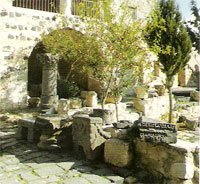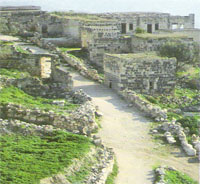Visit this Greco-Roman town, also mentioned in the Bible, snugly located in a hillside of northern Jordan, and marvel at the sweeping view of Lake Tiberias and the Golan Heights from atop this Decapolis. Kindle that transcendental feeling, as you walk through the path of ancient flourishing civilizations, their remnants telling the story of the many travellers who entered its ancient gates; from the Macedonians, who first established their acropolis, to the Romans, Byzantines, Umayyads and Ottomans.
Join us for a fulfilling experience!
Umm Qais (Gadara)
Situated on a broad promontory 378 meters above sea level, this town was known as Gadara, one of the ancient Greco-Roman cities of the Decapolis, and according to the Bible, the spot where Jesus cast out the Devil from two demoniacs (mad men) into a herd of pigs (Mathew 8:28-34). In ancient times, Gadara was strategically situated, laced by a number of key trading routes connecting Syria and Palestine. It was blessed with fertile soil and abundant rainwater. This town also flourished intellectually and became distinguished for its cosmopolitan atmosphere, attracting writers, artists, philosophers and poets, the likes of Satirist Menippos (second half of the 3rd century BC), the epigrammist, Meleagros (ca.110-40 BC), and the rhetorician, Theodoros (AD14-37). Gadara was also the resort of choice for Romans vacationing in the nearby Himmet Gader Springs.
Archaeological surveys indicate that Gadara was occupied as early as the 7th century BC. The Greek historian, Polybius, described the region as being under Ptolemic control at the time. The Seleucid ruler Antiochus III conquered it in 218 BC, naming the city Antiochia and Seleucia. In 63 BC, Pompey liberated Gadara and joined it to the Roman league of ten cities, the Decapolis. Soon after, the fortunes of Gadara improved rapidly and building was undertaken on a large scale, carried out for the love of Pompey's freed man, Demetrius, who had been born there.
During these early years of Roman rule, the Nabateans (with their capital in Petra) controlled the trade routes as far north as Damascus. Unhappy with the competition, Mark Anthony dispatched King Herod the Great to weaken the Nabateans, who finally gave up their northern interest in 31 BC. In appreciation for his efforts, Rome rewarded Herod with Gadara.
The city reached its peak of prosperity in 2nd century AD and new colonnaded streets, temples, theatres and baths sprouted. Meleagros compared Gadara with Athens, which testifies to the city's status as a creative centre of Hellenism in the ancient Near East.
Christianity spread slowly among the inhabitants of Gadara. Starting from the 4th Century, its bishop attended the ecclesiastical councils of Nicaea, Chaleedon, and Ephesos. Despite his attendance, the city was no longer a seat of learning. During the 6th century, decline set in, and in AD 636 a decisive military clash between Byzantines and Arab Muslims took place not far from Gadara. However, there is no evidence of widespread destruction in the city.
Umm Qais's charm still lingers today. A large portion of the Western Roman Theatre, has survived history's upheavals. Vaulted passageway support its rows of seats, built of hard basalt stones. A row of elaborately carved seats for dignitaries stand near the orchestra, and in the centre was a large headless marble statue of Tyche, now displayed at the local museum.
A cross from the theatre is the colonnaded street [cardo], which was in all likelihood the town's commercial centre. Also, near the black basalt theatre is the Terrace , which hosts an atrium [courtyard], a church and a basilica. Further west of the Terrace and along the east-west Colonnaded Street [decumanus], ruins of the Nymphaeum, a bath complex and a well-preserved Roman Mausoleum can be seen. After a few hundred meters one can barely make out the remains of what once was a Hippodrome.
Theaters
T here are two theatres in Gadara, and a third one located at the hot springs of Himmet Gader. Remains of the North Theatre, the largest one, are still visible in the hillside (next to the museum); the well-preserved West Theatre is the most graceful feature of Gadara. Built of black basalt stones, this theatre dates back to the first and the second centuries AD. You can enjoy a particularly spectacular view around sunset from the upper rows of the seats.
Vaulted Shops
The terrace is supported by vaulted structures, used as shops during the Roman times. These shops were slightly lower than the level of the Terrace. The road was paved and a Roman sidewalk existed in this area.
Nymphaeum
The Nympheaum, a fountain with basins and niches, usually decorated with marble statuettes, is located on the Decumanus, near the intersection of the two main colonnaded streets [cardo and decumanus] and across the Terrace. This sacred monument is believed to have been dedicated to the ancient water goddesses.
Roman Baths Complex
Ruins of a Bath Complex, dating from the 4th century, can be seen by merging left into a small dirt road some 100 meters from the intersection of the Colonnaded Streets. You can also access its lower parts from a dirt road across from the West Theatre. Just as typical Roman baths, it had hot, warm, and cold rooms, as well as a room for disrobing. It apparently went out of use in the early 7th century .
Tombs
A pproximately 500 meters from the Roman Baths you will find a well-preserved underground Roman Mausoleum [West Mausoleum]. Behind the black basalt stone cistern [underground water reservoir], steps lead to the entrance hall, which is the porch of the mausoleum itself. A five-aisled Basilica Church was recently excavated above the mausoleum. You can also find rock carved tombs scattered around the outskirts of Gadara, such as the tombs of Germani, Modestus and Chaireas.
The Western Gate\Gate of Tiberias
S ome 800 meters from the point where the two main colonnaded streets intersect, or 200 meters from the Mausoleum, you will find the remains of the Western City Gate, consisting only of the foundations. The gate was flanked by circular towers, which straddled the Decumanus. Another 400 meters from the Western Gate there are the remains of a Triple Arched Gateway, which marked the extension of the city's boundary in the latter half of the 2nd century.
The Terrace
N ext to the West Theatre is the paved and colonnaded Terrace. Some of the structures that remain on the terrace include the colonnaded atrium, which served as the courtyard for the church, a large colonnaded octagon pertaining to the Centralized Church and an apse, remnants of a three-aisled Basilica located between the Centralized Church and the West Roman Theatre. To the west, the Terrace is supported by vaulted structures.
Centralized Church
This church is located on the Terrace and dates to the Byzantine period. The complex consists of a plaza and colonnade. A central octagon of columns capped with Corinthian capitals taken from a temple preceding the church, supported the roof of the Centralized Church.
Living Quarters
A classical Acropolis lies to the east of the West Theatre. Today it is covered by Bait Melkawi and the remains of the Ottoman village, built from stones taken largely from ancient buildings. One of the more substantial buildings was restored and converted into a museum, while another was rebuilt as a rest-house.
Museum of Umm Qais
Located in Beit Al-Russan (House of Al-Russan), the Museum was originally the Ottoman governor's house. Statues, mosaics, coins, among other archaeological finds, are on display. Opening hours of the museum are: Everyday from 8:00-18:00 in summer and 8:00-17:00 in winter. For more information contact the museum: 00 962 2 7500071 .







